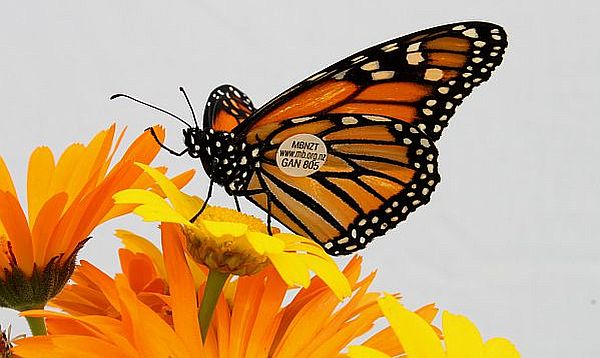Walla Walla, Washington – When a young girl named Rosie found a Monarch butterfly resting on the garage door of her house in Bolinas, California, last year, she noticed it had a small, white tag on its wing with a Washington State University e-mail address and an identification number.
She sent a message to WSU entomologist David James, and he recorded that in six weeks the butterfly had made a 600-mile journey from its release in Yakima, Washington, to the coastal town north of San Francisco. The Monarch was one of 12 recaptures from the first year of a rearing and tagging project completed by a small group of offenders — nicknamed the "Butterfly Wranglers” — at Washington State Penitentiary who are raising butterflies for research.
After a successful first year of the butterfly rearing program at the prison, hundreds of Monarch butterflies will be released in September as part of a WSU study answering the question: where do Monarchs in the Pacific Northwest go?
Decreasing Populations
For decades, scientists have known that Monarch populations in the eastern half of the US make their way to Mexico for the winter and then return north. Earlier this year the iconic butterfly made headlines when the number of Monarchs in Mexico hit a record low and brought up concerns about decreasing populations. The Monarch population in the western US has historically been much smaller than that in the east, and prior to James' study, there had only been one or two Pacific Northwest monarchs tagged and recaptured. They also landed in California, but in the 1990s.
James believes Monarchs may be heading to California for the winter, but also further south to Mexico. One Monarch from last year's release was spotted in Utah — so, while off course if trying to reach California, James said it was "tantalizing evidence” that it may have been on its way to Mexico.
It will take several years to raise and release the thousands of butterflies needed to gather enough data to make any firm conclusions, said James, but utilizing the Butterfly Wranglers' time and skill at the prison has greatly contributed to the amount of research they've been able to conduct.
"The inmates get such great benefits from this project," he said. "The interest and the motivation from rearing the butterflies gives them helps them become invested in bettering themselves and contributing to scientific research."
Program Expanding to Wine Industry
It's been such a successful program, he said, that they are introducing a new project with benefits to the Washington wine industry. Now, the Butterfly Wranglers are counting mites and insects on grape leaf samples and will be rearing smaller, more delicate native butterflies as part of a project to integrate native plants and pollinators into vineyards.
While most of the Monarch butterflies will be released outside of the penitentiary this month, the Wranglers will tag and release a few hundred of the butterflies they reared. As the butterflies head into the wild this month, only time, and a sharp eye from citizen scientists, will tell where they'll land next.
The Monarch butterflies at Washington State Penitentiary are tentatively scheduled to be released the week of September 23rd.
Report sightings to monarch(at)wsu.edu, and visit the Monarch Butterflies in the Pacific Northwest Facebook page for updates.


